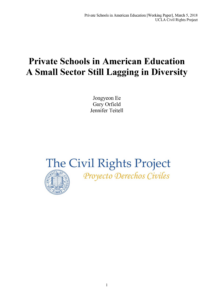This is 1 of 4 studies (working papers) presented on March 5, 2018 on Capitol Hill at a briefing, “Bringing Civil Rights Research to Bear on Voucher Programs: Are the Promises Realized?”
SUMMARY
The District of Columbia has the nation’s only school voucher program established and funded by the federal government since 2003.
Why? Congressional proponents urged parental choice as a value in itself, principally as a means to equalize educational opportunity for low-income students, giving them the same options as their wealthier peers to receive a higher quality education through escape from low-performing public schools, and to improve DC’s public schools through competition.
How has the District of Columbia private school sector changed since then? The number of schools in the entire sector and in the voucher program has declined in the face of increasing competition from DCPS (DC Public School district) schools in affluent neighborhoods and charter schools generally, as well as rising costs and declining enrollment in Catholic Archdiocese schools. Total private school enrollment has both decreased and become whiter, while white enrollment in the public sector has also increased, reflecting a significant increase in the white population.
Effectively, how broad is the choice for DC voucher students? The constraints of affordability, transportation, needs for services such as special education and ESL, and admissions requirements and practice limit the choice considerably. In SY 2011-12, the one year where OSP student enrollment by school is available, students are clustered in low-tuition, religiously affiliated schools in low-to middle income neighborhoods. Very few are enrolled in the elite high-tuition schools in affluent neighborhoods attended by their wealthier peers.
Do participating students receive significant benefit from the program – academic achievement and safety/security, as compared with students in DCPS and charter schools? Evaluations of both phases of the Opportunity Scholarship Program (OSP) program found no significant effect on academic achievement. In the second phase there was some evidence of academic loss. Graduation numbers were significantly higher for the earlier group, but without knowing graduation standards, it is hard to assess this finding. Most families seem sufficiently satisfied to keep their children in the participating private schools, but statistically satisfaction differs little, if at all, from that of families who did not receive awards and remained in their DCPS or charter schools.
Do participating students experience a greater or lesser degree of racial and ethnic integration than those in DCPS and charter schools? Private schools in DC are less segregated with a large majority of white students, but 70% of participating voucher students were enrolled in severely segregated schools with 90% or more minority students and a full 58% were in all-minority schools.
What information and data not currently available are needed to answer these questions and better evaluate the worth of the program? Basic information is very hard to come by. At the least, we should know the number and names of all private schools and basic statistics such as their enrollment and attendance, OSP enrollment data by school, and quality measures, all of which are now unavailable.
What might a national federal government voucher program look like? The D.C. program is funded completely by federal funds with the added feature of providing public schools with funds they would have had for the private school students they do not enroll – a feature not typical of existing state/local programs. The cost of a nation-wide voucher program would be considerable even without such a pay-off.
Would a federal program even cover the cost of private school tuition and fees, or – like special education – would it become a largely unfunded mandate on state and local government? If the program followed the pattern of the D.C. system, student access would be largely limited to low-tuition schools, most with religious missions. Parents seeking an exit from public schools would sometimes face the issue of placing their children in a school whose basic mission is teaching a religion different from their family’s faith. Participating schools would pick their students, and be free to reject students who are low-achieving, with disabilities or with limited English. Accountability would consist of parent ability to move to a different school, without standards for student performance and little data or other information by which to judge quality. As has been found in studies of state and local voucher programs, achievement of participating students would be about the same as their demographically similar public school peers.
In compliance with the UC Open Access Policy, this report has been made available on eScholarship:
